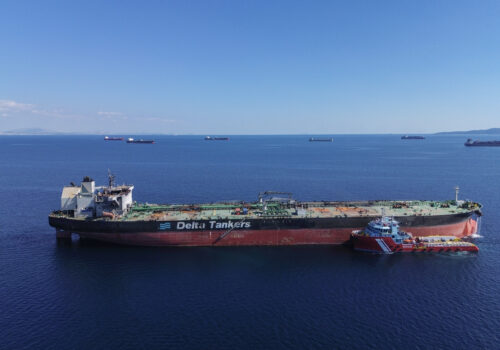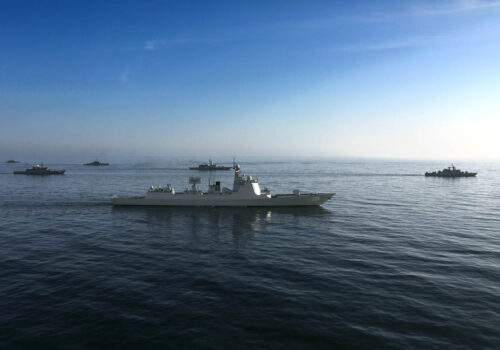Iran, China, Russia, and the collapse of deterrence in the Red Sea
A Chinese warship pointing a laser at a German surveillance aircraft on July 2, 2025 might be the perfect metaphor for the new maritime reality: multiple powers now patrol the same waters with different mandates, different rules, and increasingly different interpretations of acceptable behavior. The German plane was on a routine patrol mission, part of the European Union’s (EU) Operation Aspides, when a Chinese laser triggered security precautions, forcing the aircraft to abort and return to base.
Beijing deflected and denied the incident, with China’s Ministry of National Defense, stating that “the Chinese naval vessel fleet was carrying out escort missions in the Gulf of Aden. It did not carry out operations in the Red Sea, nor activate any laser equipment.” However, the suspected Chinese vessels had conducted joint Maritime Security Belt 2025 exercises with Russian and Iranian forces in the Gulf of Oman just four months earlier, suggesting the laser incident—whether real or perceived—was not isolated harassment but part of coordinated pressure against Western operations.
That same week, events in the Red Sea took a deadlier turn. The week of July 6 delivered a cascade of strategic humiliations for the West in the Red Sea: the laser incident, the sinking of the Liberian-flagged, Greek-operated Magic Seas and Eternity C vessels, the killing of four sailors and capture of six in Houthi custody, most of which were Filipino. These are not random escalations of violence, but choreographed demonstrations of a new maritime order. When the Iran-backed Houthi forces filmed themselves boarding the abandoned Magic Seas, planting synchronized explosives while chanting “death to America, death to Israel, curse the Jews,” the propaganda value was calculated.
SIGN UP FOR THIS WEEK IN THE MIDEAST NEWSLETTER
This violence didn’t emerge from nowhere. It filled a vacuum the West created through miscalculations like the 2018 Stockholm Agreement, which legitimized Houthi control over key Red Sea ports while the United Nations (UN) celebrated diplomatic “progress.” The resulting confusion between diplomatic theater and strategic reality became a recurring pattern in which the West consistently chose containment over confrontation, a pattern that has proven recurring.
That pattern held until the Houthis revealed their hand on October 7, 2023. Their simultaneous campaign against maritime commerce and Israel demonstrated the operational coordination Tehran had cultivated among its proxies. By framing maritime terrorism as Palestinian solidarity, the Houthis sought to legitimize economic warfare while exposing the West’s vulnerability to asymmetric threats.
Western reluctance to risk a conflict in the Red Sea, while understandable, created paralysis when decisive action was needed. The escalation trajectory that followed illuminated a fundamental strategic divergence within the Western alliance over how to deal with the Houthis. When US President Donald Trump launched Operation Rough Rider in March 2025, deploying “overwhelming lethal force”to try to end the Houthis’ attacks on Red Sea shipping after soft power had demonstrably failed, it exposed the incoherence at the heart of Western strategy. European capitals, having invested political capital in Operation Aspides’ explicitly defensive mandate, found themselves defending a paradigm that events had already discredited. Their confusion over whether that escalation or accommodation posed the greater threat, even as shipping lanes collapsed, reflected institutional commitment to diplomatic solutions regardless of the belligerent ground realities.
Meanwhile, the operation faced domestic discord in the United States, amplified by media coverage questioning Washington’s rationale. The resulting political confusion combined with the $1 billion in expenditures and significant material losses, including two fighter jets, the operation failed to achieve its deterrent objectives. This created pressure and political incentives for the administration to accept what was effectively a Houthi terms; a cessation of attacks on US vessels in exchange for their continued freedom to target Israeli shipping.
That domestic pressure on the current administration culminated in the May 6 ceasefire between the United States and the Houthis, which revealed the structural limitations of unilateral military action in asymmetric warfare. The agreement’s terms, which called for an end to Houthi attacks on American ships, might have seemed like de-escalation at that time, but it did not address the group’s targeting of Israeli-linked vessels, which ultimately institutionalized a two-tier system that validated Houthis’ strategy of selective maritime terrorism. The West’s inability to develop a coherent response to militia control of shipping lanes ultimately created a strategic vacuum that China and Russia, with the help of Iran, were quick to exploit.
The trinity of opportunism
The Red Sea crisis revealed how rival powers can achieve strategic alignment through parallel pursuit of individual interests, creating cumulative effects that exceed what any could achieve alone. These powers have discovered that pursuing individual interests in parallel creates mutually reinforcing systemic effects. The West faces not a conspiracy but something potentially more challenging: organic alignment of adversarial interests that requires no central planning to sustain and offers no single point of leverage to pressure.
This alignment shows up everywhere. While China and Russia condemned attacks on civilian shipping publicly: On July 15, 2025, China and Russia abstained from UN Resolution 2787 on Houthi attacks, revealing the gap between diplomatic statements and actual policy. China warned against “misinterpreting or abusing” Security Council resolutions to justify military action against Yemen (which in reality, eases pressure on the Houthis, not Yemen). This pattern allows states to maintain formal diplomatic norms while pursuing contradictory strategic objectives.
The Houthis, for their part, achieved sophisticated operational adaptation in their use of captured assets. The Galaxy Leader, a Bahamas-flagged car carrier hijacked by the militias in November 2023, was converted into a floating radar station equipped with surveillance systems to track maritime traffic. This transformation shows how Iranian-backed proxies leverage state-level capabilities for asymmetric warfare. This blend of advanced intelligence gathering with theatrical violence, all justified through Palestinian solidarity narratives, provides both tactical advantages and strategic cover for what amounts to maritime terrorism.
But China’s material support represents the most significant enabler of Iranian capabilities. The shipment from Chinese ports, enough to fuel 260 medium-range missiles according to Financial Times calculations, illustrates Beijing’s willingness to undermine non-proliferation norms when it serves its interests. Their characterization of missile precursor chemicals as “normal trade” reveals how authoritarian powers exploit regulatory ambiguities to advance strategic objectives.
Earlier in March, Conflict Armament Research discovered Houthi drones now incorporate Chinese-made hydrogen fuel cells, tripling their range while reducing their heat signature, making them nearly invisible to traditional defenses. Components arrive mislabeled as oxygen cylinders, exploiting customs loopholes to deliver the first attempted use of hydrogen fuel in un-crewed systems by any non-state armed actor, globally.
This technological transfer occurs alongside a broader economic arrangement that reveals China’s calculated approach to the crisis. Despite pressure on European vessels, Chinese ships sail unmolested through the same waters. US Treasury sanctions confirmed that Houthi leader Mohamed Ali Al-Houthi has “communicated with officials from Russia and the People’s Republic of China to ensure that Houthi militants do not strike Russian or PRC vessels transiting the Red Sea.”
Meanwhile, Russia’s contribution to this arrangement in the Red Sea completes the nexus, maintaining its traditional position as a mediator between chaos and order. The Wall Street Journal’s October 2024 revelation that Russia provided satellite data to the Houthis through Iranian Revolutionary Guard Corps intermediaries fits a pattern of escalating involvement. Meanwhile, Viktor Bout’s August 2024 meeting to arrange $10 million in small arms sales to the militant group, including AK-74s and potentially Kornet anti-tank missiles, demonstrates Moscow’s willingness to use even its most infamous assets to fuel regional instability.
Overcoming paralysis in the Red Sea
Current policy frameworks face multiple limitations: reluctance to arm Yemen’s government due to governance concerns, resource constraints while supporting Ukraine, and the demonstrated failure of UN-mediated agreements like Stockholm. These constraints create operational gaps that regional actors exploit.
The divergent approaches are evident: China enforces its maritime arrangements through direct action, Russia provides intelligence support to proxies, and Iran maintains supply chains for missile components despite sanctions. This coordination occurs without formal alliance structures, suggesting alternative models of strategic cooperation.
First, multilateral frameworks require reassessment. The Stockholm Agreement and Operation Rough Rider failed for opposite reasons: one trusted process over power, the other trusted power over partnership. Success requires genuine integration: joint command structures between US and European forces, shared intelligence platforms combining Israeli capabilities with European surveillance and American signals intelligence, and synchronized rules of engagement. European Operation Aspides and US efforts currently operate in parallel; they need operational fusion and should include Asian democracies to break Beijing’s East-versus-West narrative.
Second: Connect maritime extortion to broader strategic competition. The Red Sea crisis requires reframing from isolated incidents to a coordinated strategy. The Houthis’ attacks serve Iran’s regional ambitions, China’s commercial advantages, and Russia’s goal of diverting Western resources, not the Palestinian solidarity as they claim. Any serious analysis must consider how this Iran-China-Russia arrangement weaponizes shipping lanes to fracture Western alliances and establish new models for degrading American influence. The strategic insight is this: adversaries have discovered they can make Western leadership unaffordable without firing a shot. Recognizing these connections enables a more effective response than treating each crisis in isolation
Third: Recognize Yemen as Iran’s bid to control strategic waterways. The international community’s “civil war” framing obscures Tehran’s real objective: controlling multiple maritime chokepoints. Iran already leverages the Strait of Hormuz to threaten energy flows and is now seeking to replicate this leverage at Bab el-Mandeb through its Houthi proxies. If successful, controlling both chokepoints would give Iran unprecedented ability to throttle global commerce. To achieve this, the Houthis serve as both a domestic movement and an Iranian expeditionary force positioned to capture strategic geography for Tehran’s benefit. Given these stakes, supporting Yemen’s UN-backed government now costs far less than confronting Iranian control of multiple chokepoints later.
The Iran-China-Russia convergence has demonstrated that patient adversaries can partition the global commons while democracies debate response options. They’ve shown that maritime terrorism can be rebranded as resistance, that economic warfare can be selective, and that international law applies only to those who choose to follow it. The infrastructure for response exists but what’s missing is the recognition that inaction is itself a choice, one that adversaries interpret as permission.
Russia’s pursuit of a permanent Red Sea naval base reveals the most damning calculation: they’re betting Western control won’t return. As Ilya Kramnik of the Russian International Affairs Council argues, this advances “Russia’s role as a global power”, not hedging against Western recovery, but assuming its absence.
For eight decades, deterrence meant challenging the Western-led international order brought automatic consequences. But the last ten days of choreographed violence in July proved otherwise. China, Russia, and Iran systematically dismantled Western maritime control while staying below retaliation thresholds, making deterrence optional rather than automatic. Every potential adversary worldwide just learned that lesson, and that with just enough pressure and confusion, the West will create the vacuum for them to exploit.
Fatima Abo Alasrar is a Senior Analyst with the Washington Center for Yemeni Studies and a Board Member of Peace Track Initiative. She can be found on X at @YemeniFatima.
Further reading
Mon, May 5, 2025
How China turned the Red Sea into a strategic trap for the US
MENASource By
Beijing’s proxy warfare turns global trade routes into battlefields that the United States struggles to defend.
Fri, Jun 13, 2025
China’s basing quest in the Gulf: Pipe dream or strategic reality?
MENASource By
While the Gulf remains central to China’s long-term maritime aspirations, its near-term military footprint is likely to stay limited.
Mon, Apr 7, 2025
Can Donald Trump ‘completely annihilate’ the Houthis in Yemen?
MENASource By Emily Milliken
The Trump administration’s Houthi strategy will require a more nuanced approach that deepens these non-military components.
Image: FILE PHOTO: A vessel said to be Greek-operated, Liberia-flagged Eternity C sinks in a footage released by Yemen's Houthis, in the Red Sea, in this screen grab taken from a handout video released on July 9, 2025. HOUTHI MEDIA CENTER/Handout via REUTERS THIS IMAGE HAS BEEN SUPPLIED BY A THIRD PARTY/File Photo



